Our Products & Services
Getting Started
First Time Setup
Getting Started With Jobs
Getting Started with Accounts
Getting Started with Inventory
Getting Started with Ticketing
Setting Sonar up for Billing
Baseline Configuration
How To: Using Sonar's Customer Portal
User Specific Resources
Accounts
Account Groups: Overview & Example Use Cases
Account List View: Overview
Account Management View: Overview
Account Overview Customization
Account Statuses: Overview & Example Use Cases
Account Types: Overview & Example Use Cases
Anchor & Linked Serviceable Addresses: Overview and Best Practices
Archiving an Account: Overview
CPUC Fixed Broadband Deployment by Address
Child Accounts: Best Practices & How Tos
Creating a New Account
Direct Messages: Overview
Disconnecting an Account
Disconnection Reason Management: Overview
Exploring Task Groups
FCC Broadband Data Collection (BDC) Filings: How Sonar Can Help
FCC Data Exports: General Overview and Usage
Future Serviceable Addresses: Overview
Lead Intake Form Processing
Notes: Best Practices & Use Cases
Scheduled Events: Overview & Use Cases
Serviceable Addresses: Overview and Usage
Specify Account ID upon Creation
Tasks & Task Templates: Overview
Using Sonar's FCC Broadband Label Generation Tool
Billing
ACH Batching: Overview
Accounts in Vacation Mode
Avalara: Overview & Setup
Batch Payments & Deposit Slips: Overview
Billing Calculator
Billing Defaults
Billing Settings
Building Packages
Building a Data Service
Canadian ACH tool
Changing Service Pricing in Sonar: Best Practices
Considerations When Using Avalara with Voice Services
Creating Discounts for Services and Packages
Delinquency Billing Best Practices
Delinquency Exclusions: Overview and Use Cases
Dual Data Services: Overview
Email Invoice Batch: Overview
General Ledger Codes: Overview
General Transactions: Best Practices
How Sonar Prorates Billing
How to Take Bank Account Payments
How to: Adding a Service to an Account
Invoice Templates: Overview
Leveraging PayPal as a Payment Method in Sonar
Manual Transactions
Multi-Month Billing & Multi-Month Services
Print to Mail
Printed Invoice Batches: Overview
Services: Overview
Setting Up Payment Methods and Taking Payments
Setting up Bank Account & Credit Card Processors
Taxes Setup
Usage Based Billing Policies: Overview and Usage
Usage Based Billing Policy Free Periods: Overview and Usage
Using Tax Exemptions - How To
Communication
Communications: Call Logs Overview & Best Practices
Communications: Messages Overview
Email Variables & Conditions
Message Categories: Overview & Use Cases
Phone Number Types: Overview and Use Cases
Saved Messages: Overview
Setting up an Outbound Email Domain
Trigger Explanations
Triggered Messages: Setup
Using Outbound SMS
Using the Mass Message Tool
Companies
How to: Setting Up a Company in Sonar
Managing Multiple Companies in Sonar: Best Practices
Rebranding your Sonar Instance
Financial
Contract Templates
Invoice Attachment Use Cases & PDF Examples
Invoice Messages: Overview & Use Cases
Invoices in Sonar: Examples, Creation & Contents
Integrations
Atlas Digital CORE Integration
Calix Cloud Data Field Mappings
Calix SMx Integration: Overview
CrowdFiber Integration
External Marketing Providers
GPS Tracking Providers: Overview
GoCardless Integration: Overview & Setup
How to Connect Cambium to your Sonar Instance
How to Connect Preseem to your Sonar System
How to: Using Webhooks in Sonar
Integrating with Calix Cloud
RemoteWinBox - Integration with Sonar
Sonar Retain: AI-Powered Customer Retention & Quality Intelligence
The Sonar Field Tech App
Tower Coverage Integration: Overview
VETRO FiberMap V2 Integration: Overview
VETRO FiberMap V3 Integration: Overview
Webhooks in Sonar: Basic PHP Example
iCalendar Integration
Inventory
Inventory List View: Overview
Inventory Model Management: General Overview
Network Inventory: How-to & Usage Guide
Segmentable Inventory: How-to & Usage Guide
Setup of Inventory: Manufacturers, Categories, and Assignees
Tracking and Using Consumable Inventory
Jobs
Applying Task Templates to Jobs
Edit Job Options
Example Jobs & Templates
Geofences: Overview
Job Types: Best Practices
Jobs and Scheduling: Overview
Scheduling How-to: Creating and Booking a Job
Scheduling Week View: Overview
Setting Up Schedules General Overview
Mapping
Misc.
Combining Custom Fields & Task Templates for Information Storage
Custom Fields Overview & Use Cases
Custom Links: Overview
Task Templates Overview & Use Cases
Monitoring
Building Alerting Rotations
Building a Monitoring Template
Poller Troubleshooting
Pollers: General Overview, Deployment Strategy, Build Out & Setup
Networking
Adtran Mosaic Cloud Platform Integration: Overview
Assigning RADIUS Addresses
Assigning an IP Address Using Sonar's IPAM: How to
Automating IP Assignments, Data Rates, and Network Access in Sonar
Building Address Lists
Building RADIUS Groups
Building a Device Mapper
Cable Modem Provisioning
Controlling Customer Speeds with Sonar: General Overview
DHCP Delivery
Data Usage Available Methods
Finding your OIDs
FreeRADIUS 3: Build-Out & Integration
How Sonar Communicates - Egress IPs Explained
IP Assignments & Sonar
IPAM: Basic Setup
IPAM: Overview
LTE Integration
MikroTik as an Inline Device: Integration With Sonar
MikroTik: Controlling Access
MikroTik: Controlling Speeds
MikroTik: Setting Up a Sonar Controlled DHCP Server
Netflow On-Premise Integration: Setup and Overview
Network Dashboard: Overview
Network Sites: Management View Overview
PacketLogic: Integration With Sonar
Pulse, Polling, and PHP
RADIUS: Build-Out & Integration with Sonar
RADIUS: Building Reply Attributes
Setting Up CoA Proxy
Sonar Flow
Sonar IP Addressing
Using Multiple Network Devices in Sonar
Purchase Orders
Release Notes
Reporting
Enhanced Business Intelligence - Tips & Tricks for Advanced Users
How To Enhance Your Reporting With Custom Field Data
Report Licenses
Sonar's Business Intelligence: Overview
Understanding Sonar Reports
Using Sonar DataConnect to Connect BI Applications with Your Sonar Instance
Security
Application Firewall: General Overview and Best Practices
Auth0: Overview
Multi-Factor Authentication: Overview
Password Policy In Depth
Removing a Terminated Employee In Sonar
Role Creation using GraphiQL
User Role Creation & Best Practices
Users: Overview
Sonar Billing
sonarPay
sonarPay Canada Disbursements: Overview
sonarPay Chargebacks & Disputes: Overview
sonarPay Disbursements: Overview
sonarPay Monthly Statement: Overview
sonarPay Overview
sonarPay Reversals, Voids, & Refunds: Overview
sonarPay: Token Migration Process
System
A Deeper Dive into the New Sonar API
API Calls Using Third Party Applications: Personal Access Tokens
Browser Compatibility and Minimum Hardware Requirements for Sonar
Consuming the Sonar API
Controlling Your Landing Page: Personal Preferences
Customizing Your Customer Portal
Date/Time Picker: Overview
Dynamic Time Zones in Sonar
Filtering: Overview
Frequently Used Terms
Getting Your Data into Sonar
GraphQL Rate Limiting Overview
How To Use GraphiQL to Understand the Sonar API
How Your Data is Backed Up
How to Best Use Global Search
Interacting with Files via the API
Introducing the New Sidebar
Main Menu: Overview
Mutations in the Sonar API
Notification Preferences
REST API Wrappers for V1 Compatibility
SMS Notifications
Sonar's Rich Text Editor
System Settings: Overview
The New Sonar API
Troubleshooting the Customer Portal
Upgrading your Ubuntu OS - Customer Portal Upgrades
User Profile: Your Personal User Settings
Ticketing
Advanced Ticketing Features
Canned Replies Examples & Templates
Canned Reply Categories
Exploring Ticket Groups
How Sonar Manages Spam Tickets
How to Integrate Inbound Mailboxes with Slack
Inbound Mailboxes Example Build
Ticket Category Families & Ticket Categories: Overview
Ticket Resolution Reasons: Overview
Ticketing: Overview
Using Parent Tickets
Voice
API Changes for Voice Billing
Best Practices to Remain CPNI Compliant
Billing Voice Services in Sonar
Deploying Voice Services in Sonar
Working With the Sonar Team & Additional Resources
Sonar's Security Practices & Certifications
Sonar and General Data Protection Regulation (GDPR)
Sonar's Security Strategies
Technical Security Overview
Best Practices for Fast Tracking a Support Request
Feedback Portal / Suggest a Feature
Learning with Sonar: Tools and Resources
New Client Training Overview
Sonar Casts Table of Contents
Submitting Bugs vs. Feature Requests
The Sonar Community Forum
The Sonar Status Page
Third Party Customer Support Referrals
Table of Contents
- All Categories
- System
- Getting Your Data into Sonar
Getting Your Data into Sonar
 Updated
by Mitchell Ivany
Updated
by Mitchell Ivany
Read Time: 6 mins
The Data Import tool allows you to bring external data into your Sonar instance seamlessly. This tool is designed to take your data, and your organization methods, and convert it into the format(s) Sonar uses. This is largely accomplished by the manual association of headers that Sonar expects to see with the data you provide.
Prerequisites for Data Import
To use the Data Import tool, you need to ensure the correct permissions have been added to your user. There are 3 Data Import category permissions, and one tertiary permission that is also required. Your user role must have the following permissions enabled:
- Call Detail Record Import

- DID Import

- Voice Provider Rate Import

- And at least View permissions for Voice Providers

Accessing Data Imports
Data imports are accessible through your instance settings:
- Click on Settings
- Select Data Imports

This page contains both the button to start a new data import, and a table that provides a list of all your imports, both successful and unsuccessful.
Table breakdown
The Data Imports table is one of the few tables in Sonar that do not allow for result filtering. Instead, each column is sortable, and contains basic information about the import. For details on each column, take a look at the following section.

- The ID column shows you the ID number of the import.
- The Type column shows what kind of data was imported, based on the selection made. See Importing Data.
- The Progress column shows how far along the data import is. If an import fails once it's started, the progress will be made blank, displayed as a “-” on the table.The percentage value will update the initial 50% quite quickly, as this first half is pre-processing. The remainder will update depending on the total number of records being imported.
- The Status column provides the up-to-date import status. The displayed statuses are:
- Pending
- Invalid
- Queued
- In progress
- Successful
- Failed
- Duplicate
- The User column shows the display name of the user who initiated the data import.
- The Created column shows the date and time the import was started.
- The final column allows you to view additional details of the import.
Import details breakdown
Clicking on the “View Details” button for any import
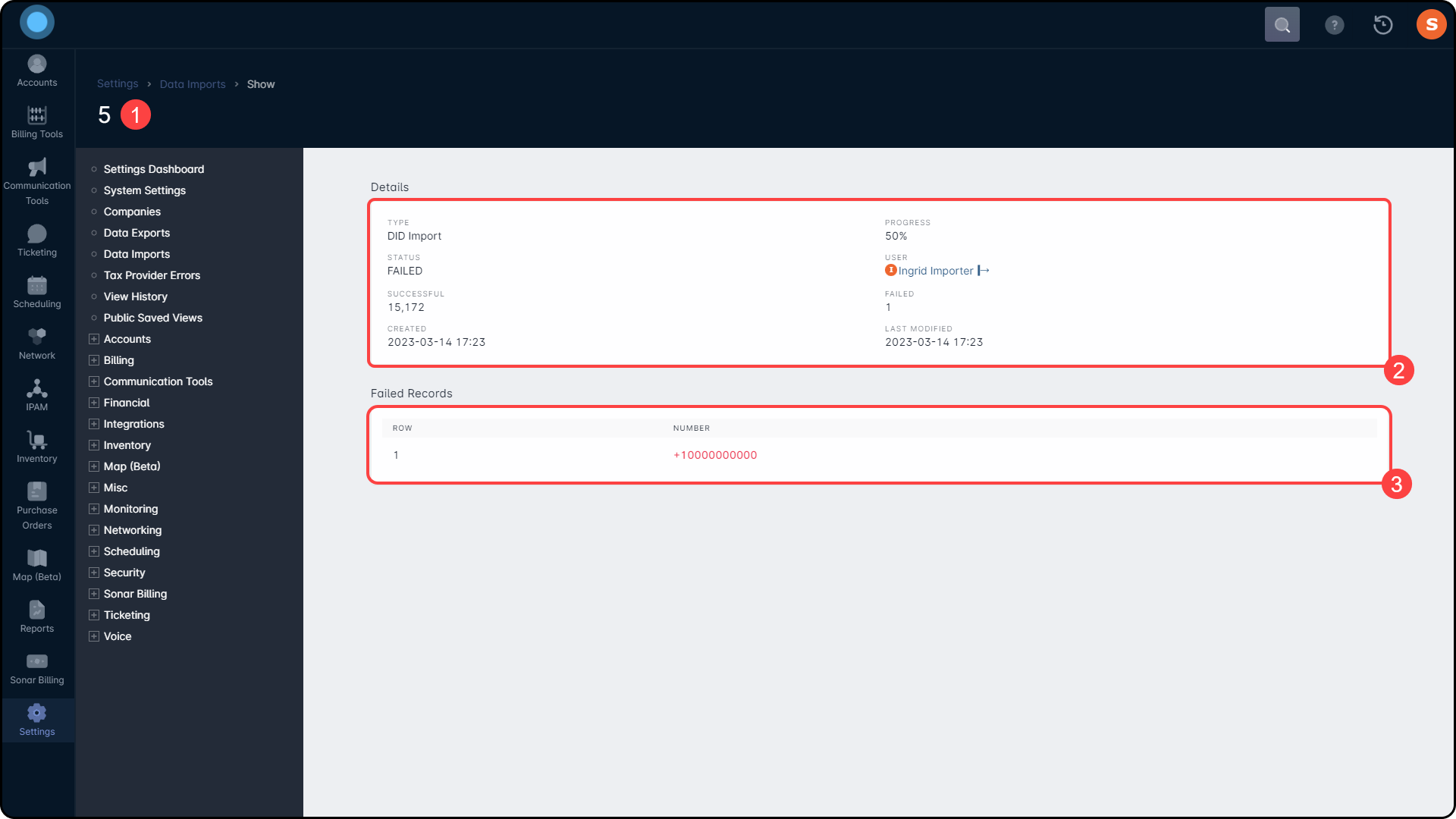
- This is the ID of the Data Import
- This section contains important information about the import, including its type, current status, and successful or failed import amounts.
- The Failed Imports section of the details page will list the details of the first 25 rows that failed.When an import fails with select rows, you can correct those values and run a new import. When an import fails, no data is imported, and so all data must be corrected and resubmitted.
Importing Data
To start the Data Import process, all you need to do is click on the  button in the top-right corner of the page. This will open the modal, where you need to select the type of data you'll be importing.
button in the top-right corner of the page. This will open the modal, where you need to select the type of data you'll be importing.

Regardless of which data type you're importing, selecting the type will open an additional details page, where you provide some additional field information.
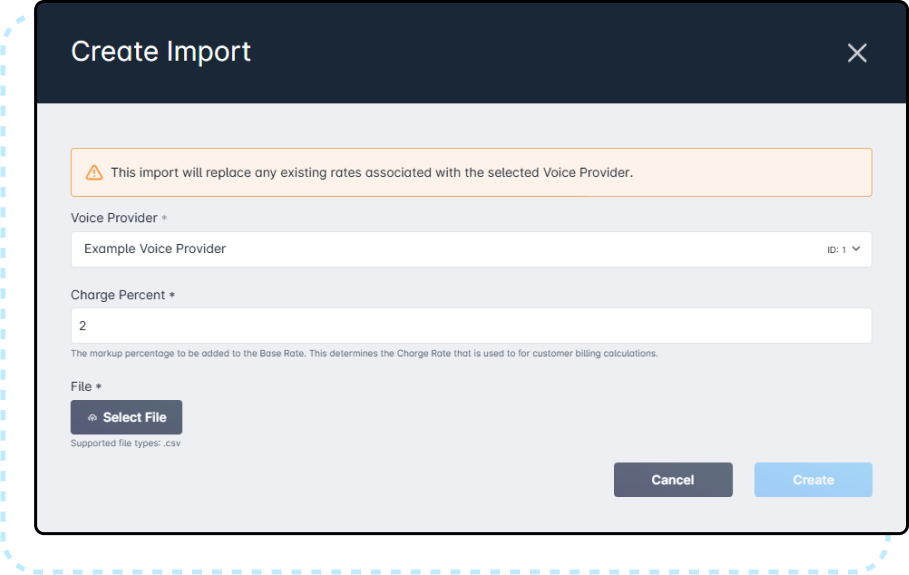
After filling out the required fields, click the “Select File” button to upload your file to your Sonar instance. This will open your operating system's native file manager, and allow you to select any .csv file on your system. While most CSV files will upload quickly, a progress bar is visible during file upload.
Create" button will remain inaccessible.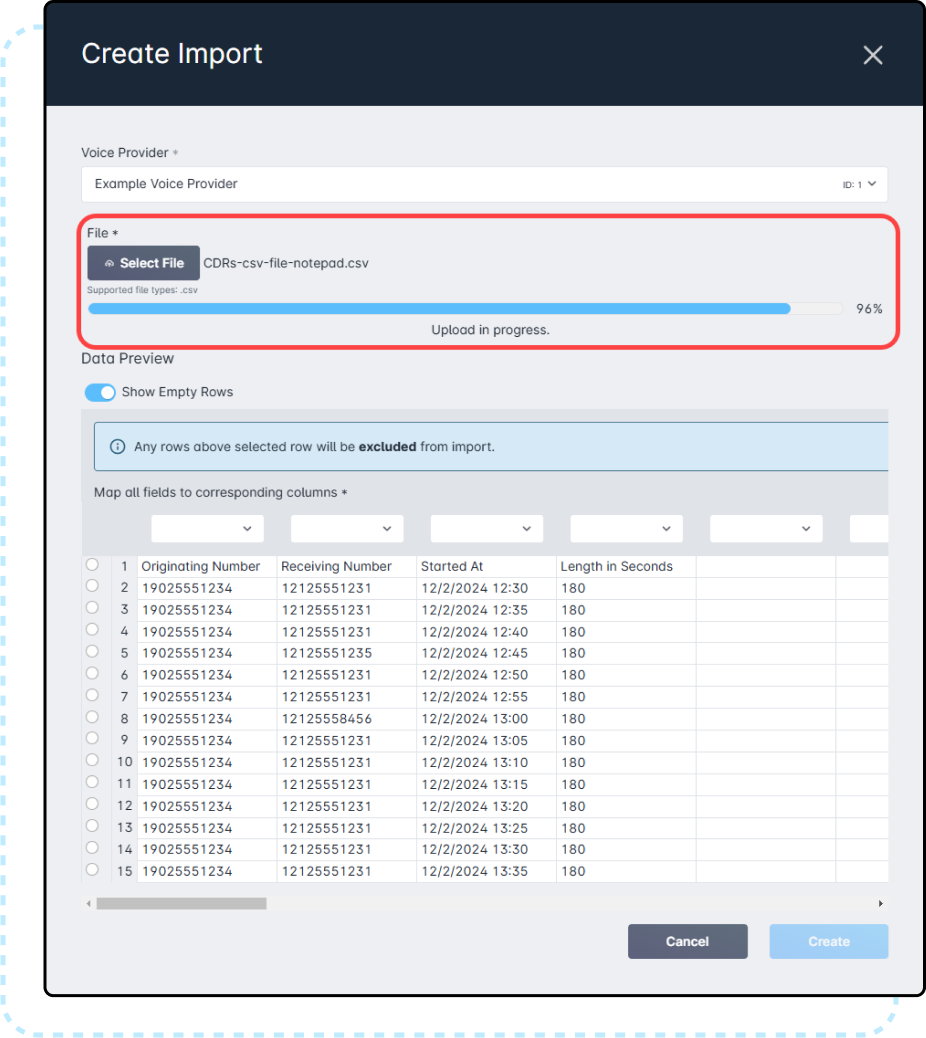
Selecting your fields
Once the file is finished uploading, you need to select which columns correspond to which headers on your dataset. Additionally, you need to select the starting row for the data import. In most cases, the starting row will be your first row with data, if your headers are included in the CSV file.
In this example Data Import, the headers are selected and the first column that contains data has also been selected. Once the upload starts, these determine how the data will be matched in Sonar. Whether your data already contained headers, or contained incorrect headers, you will still have to set them during file upload.
Choosing your headers
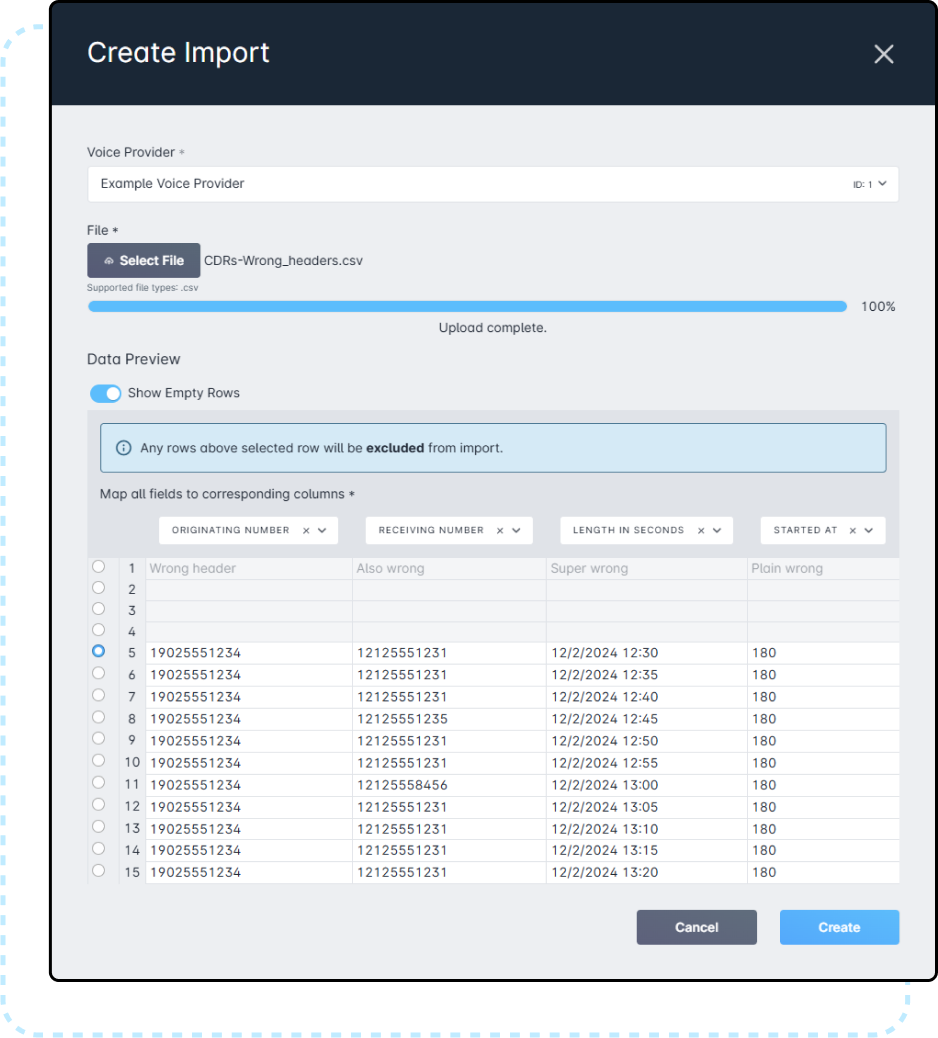
The order of your columns is equally irrelevant, as the header locations are completely variable, and will conform to your data.
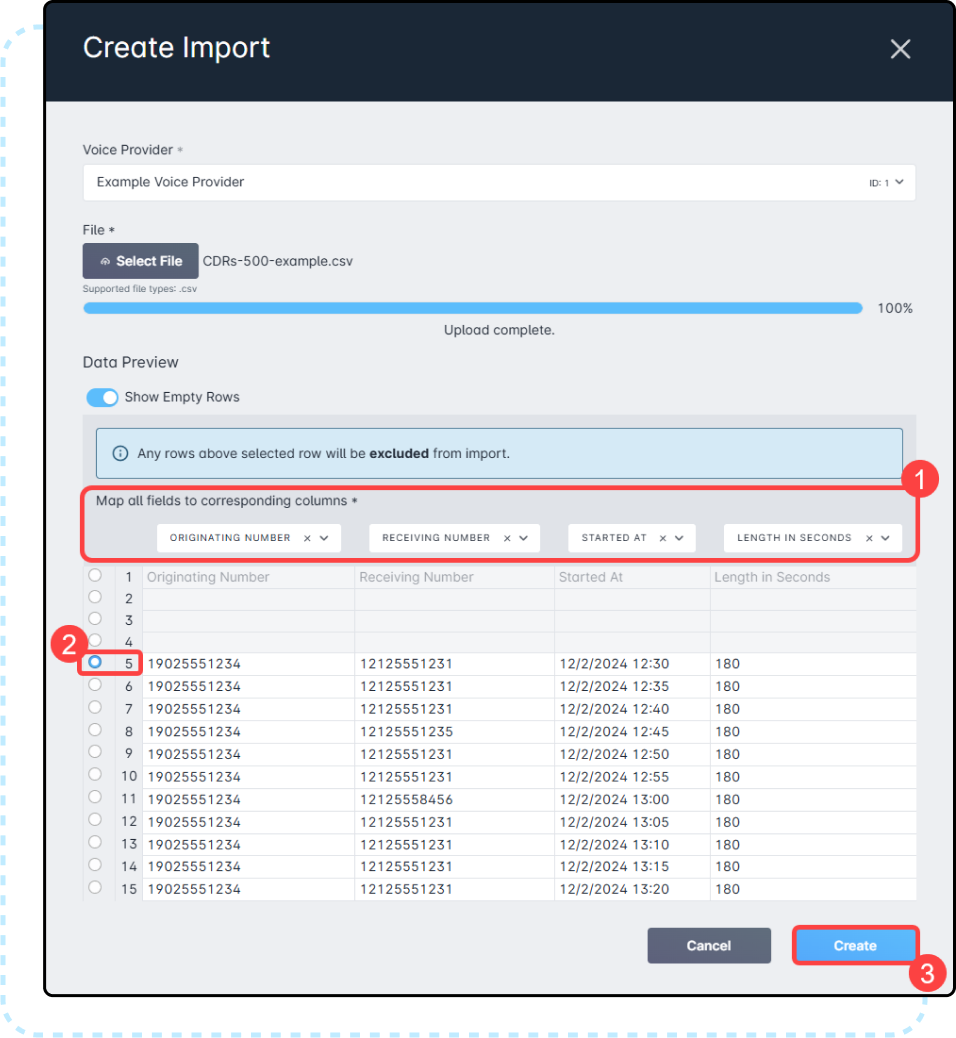
Once everything is matched, click on “Create” and the Import will start.
Create" button will remain inaccessible.Import Queues
Once an import has started, it will be queued. Every minute, the Sonar system will check for any queued imports and start the oldest one. Only one import can be running at a time, and the next import will not start until:
- The first import has completed, and
- 1 minute has passed since the last check.
What Causes Import Failures
Failures during Data Imports can occur at many stages of the process, but they all share the same root cause: your data file. Generally speaking, Sonar will be able to provide information on the cause of the import failure, but the most common failures are:
- Unmatched information – Generally, this only occurs for CDR imports, as unless the DIDs are mapped to an account, their CDR cannot be added to the instance.
- Duplicate information – This can occur across all import types, and is caused by attempting to import a record which already existsVoice Provider Rates will never experience this error, as rate decks imported to the same Voice Provider will always overwrite the older data.
- Invalid – If the data is, for some reason, completely invalid, the process will fail.
Although quite uncommon, if more than 10000 records fail in a single import, a unique failure will occur, with the following message:
The number of validation errors found in the import exceeds the limit for one attempt, and import validation is incomplete. The import may contain additional validation errors. Please make corrections and try again.
